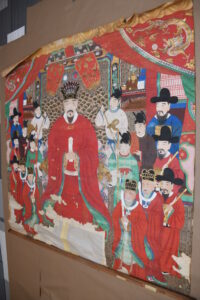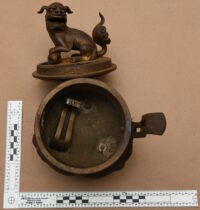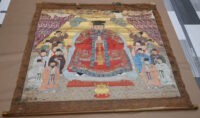 The FBI has returned 22 objects and artworks looted during the Battle of Okinawa after they were discovered in a Massachusetts attic. The artifacts were found by a family when they were going through their father’s personal effects after his death. They figured the painted scrolls, pottery, metal figurines and a hand-drawn map of Okinawa were Asian pieces that might be antiques, so they did some online research and found the painted scrolls listed in the FBI’s National Stolen Art File. The family reached out to the FBI and reported the artifacts as potentially looted cultural property and the FBI Boston Field Office initiated an investigation in January of 2023.
The FBI has returned 22 objects and artworks looted during the Battle of Okinawa after they were discovered in a Massachusetts attic. The artifacts were found by a family when they were going through their father’s personal effects after his death. They figured the painted scrolls, pottery, metal figurines and a hand-drawn map of Okinawa were Asian pieces that might be antiques, so they did some online research and found the painted scrolls listed in the FBI’s National Stolen Art File. The family reached out to the FBI and reported the artifacts as potentially looted cultural property and the FBI Boston Field Office initiated an investigation in January of 2023.
 They confirmed that the painted scrolls, map, pottery and metal objects were from the Ryukyu Kingdom, a tributary state of China (1429-1875) and vassal state of Japan (1609-1879) that ruled Okinawa until it was formally annexed by the Empire of Japan in 1879. The painted scrolls depict Ryukyu monarchs and date to the 18th and 19th centuries.
They confirmed that the painted scrolls, map, pottery and metal objects were from the Ryukyu Kingdom, a tributary state of China (1429-1875) and vassal state of Japan (1609-1879) that ruled Okinawa until it was formally annexed by the Empire of Japan in 1879. The painted scrolls depict Ryukyu monarchs and date to the 18th and 19th centuries.
The scrolls were very fragile and had to be unrolled by expert conservators to determine if they were the lost scrolls.
The FBI transported the artifacts from Massachusetts to Smithsonian Institution’s National Museum of Asian Art in Washington, D.C., where the scrolls were unfurled for the first time in many years, revealing portraits of Okinawan royalty in vivid reds, golds, and blue accents.
 The FBI compared the scrolls to old black and white photographs taken in the 1940s before they were stolen and identified them as the lost Okinawan paintings. An unsigned, type-written letter found with the collection said they were collected in Okinawa in the last days of World War II. The deceased father was a Word War II veteran, but he never served in the Pacific theater.
The FBI compared the scrolls to old black and white photographs taken in the 1940s before they were stolen and identified them as the lost Okinawan paintings. An unsigned, type-written letter found with the collection said they were collected in Okinawa in the last days of World War II. The deceased father was a Word War II veteran, but he never served in the Pacific theater.
[FBI Special Agent Geoffrey] Kelly explained that these artifacts were especially important because they depict Okinawan royalty—and serve as pieces of cultural identity. “A nation’s cultural identity is really summed up in the artifacts and the history,” said Kelly. “This is what makes a culture. And without it, you’re taking away their history. And the surest way to eliminate a culture is to eliminate their past. And so, it’s really important for us as stewards of artifacts and cultural patrimony to make every effort that we can to see that these go back to the civilizations and the cultures in the countries where they belong.”
The National Museum of Asian Art assisted the FBI in ensuring that the artifacts were properly packaged for transport. Colonel Scott DeJesse and U.S. Army Civil Affairs & Psychological Operations Command (Airborne) 38 G Monuments Men and Women led the effort to secure and transport the artifacts to Okinawa Prefecture, Japan. The Naval Criminal Investigative Service provided additional support, and FBI legal attaché office in Tokyo was responsible for the handover of the artifacts in Japan. On March 15, 2024, the official handover took place, and Denny Tamaki, the Governor of Okinawa Prefecture, announced the return of the artifacts.